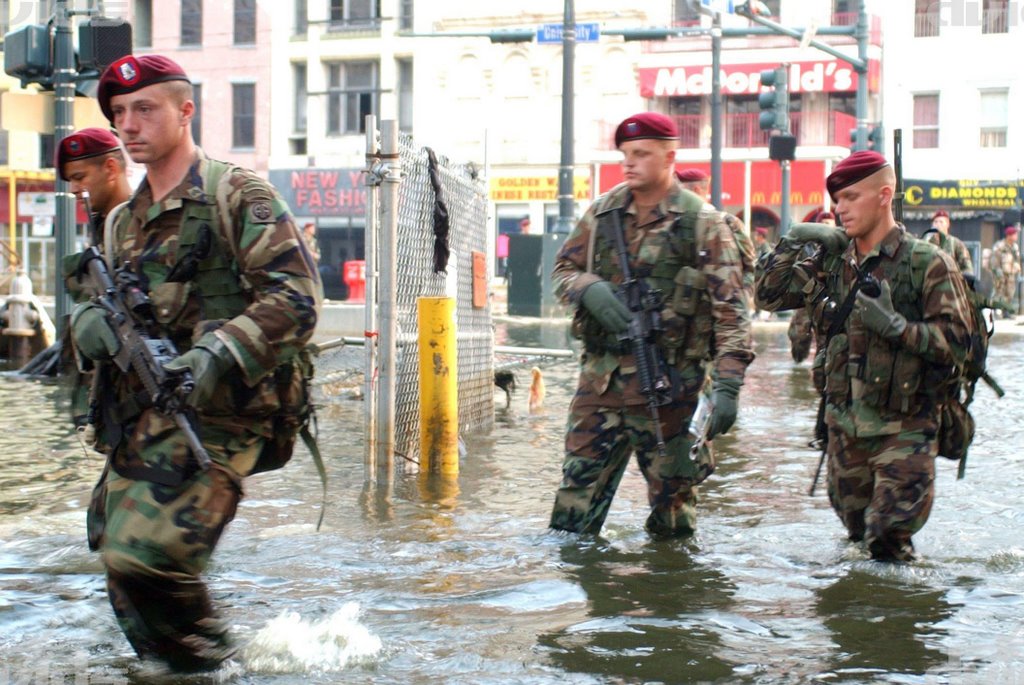Send in the Marines! (or not)
 P.L. 109-364, the defense reauthorization act, has a sleeper provision on presidential authority to use the military during disasters. The provision attempts to widen previous statutory authority substantially. I say "attempts" because I think that in reality the statute may not accomplish much, despite some bloggers who appear to think it's another presidential power grab.
P.L. 109-364, the defense reauthorization act, has a sleeper provision on presidential authority to use the military during disasters. The provision attempts to widen previous statutory authority substantially. I say "attempts" because I think that in reality the statute may not accomplish much, despite some bloggers who appear to think it's another presidential power grab.The provision reads as follows:
SEC. 1076. USE OF THE ARMED FORCES IN MAJOR PUBLIC EMERGENCIES.Section 1 seems to be an effort to give the President broad power to respond to emergencies, but there's a potentially fatal flaw. Section 1 not only requires a breakdown in public order, it also requires that section 2 be satisfied. Under current judicial doctrine, however, section 2 isn't likely to be satisfied very often -- maybe almost never.
(a) USE OF THE ARMED FORCES AUTHORIZED.--
<< 10 USCA § 333 >>
(1) IN GENERAL.--Section 333 of title 10, United States Code, is amended to read as follows:
"§ 333. Major public emergencies; interference with State and Federal law
"(a) USE OF ARMED FORCES IN MAJOR PUBLIC EMERGENCIES.--(1) The President may employ the armed forces, including the National Guard in Federal service, to--
"(A) restore public order and enforce the laws of the United States when, as a result of a natural disaster, epidemic, or other serious public health emergency, terrorist attack or incident, or other condition in any State or possession of the United States, the President determines that--
"(i) domestic violence has occurred to such an extent that the constituted authorities of the State or possession are incapable of maintaining public order; and
"(ii) such violence results in a condition described in paragraph (2); or
"(B) suppress, in a State, any insurrection, domestic violence, unlawful combination, or conspiracy if such insurrection, violation, combination, or conspiracy results in a condition described in paragraph (2).
"(2) A condition described in this paragraph is a condition that--
"(A) so hinders the execution of the laws of a State or possession, as applicable, and of the United States within that State or possession,
that any part or class of its people is deprived of a right, privilege, immunity, or protection named in the Constitution and secured by law,
and the constituted authorities of that State or possession are unable, fail, or refuse to protect that right, privilege, or immunity, or to give that protection; or
"(B) opposes or obstructs the execution of the laws of the United States or impedes the course of justice under those laws.
"(3) In any situation covered by paragraph (1)(B), the State shall be considered to have denied the equal protection of the laws secured by
the Constitution.
"(b) NOTICE TO CONGRESS.--The President shall notify Congress of the determination to exercise the authority in subsection (a)(1)(A) as soon as practicable after the determination and every 14 days thereafter during the duration of the exercise of that authority.".
When does violence resulting from a state inability to maintain public order (sec. 2(A), which is reference in section 1A) result in a constitutional violation. Since under DeShaney, the state has no duty to protect anyone except those in state custody, we would apparently need to have either a threat to the welfare of prisoners or other inmates, or a discriminatory failure ot the state to provide order (e.g., blacks are intentionally left unprotected), or a violation that does not require state action (probably Thirteenth Amendment). As to the first set of grounds, the Court indicated that as a general matter, the only federal remedy for a state failure to enforce the law had to be directed against state officers, not by independent federal enforcement. This derives from the Civil Rights Cases, which were reaffirmed when the Rehnquist Court struck down the Violence Against Women Act. So discriminatory failure to protect may not be a sufficient basis for federal law enforcement under the enforcement clause of the Fourteenth Amendcment.
This basically leaves us with 2(B), interference with the execution of federal law due to disorder. But when is this going to be satisfied, as a factual matter? In a disaster like Katrina, it was probably difficult to enforce federal law, but the reason was the disaster itself, rather than violence.
There's another puzzle about the statute. Section 1B allows presidential intervention if there's a conspiracy, etc., that involves one of the conditions in section 2 -- but section 3 seems to say that in the case of a 1B situation, section 2A is automatically satisfied because the state is deemed to have violated equal protection. (Maybe there's an additional requirement that the state be unable to eliminate the conspiracy or fail to do so? But that still seems awfully open-ended.) It seems completely unclear how sections 1B, 2A, and 2C are supposed to fit together. Dare I say that some legislative history would be useful?












1 Comments:
Correct me if I'm wrong, but isn't this a (partial) repeal of the Posse Comitatus Act? (Which, interestingly enough, has never applied to the Navy or Marine Corps.)
Post a Comment
<< Home